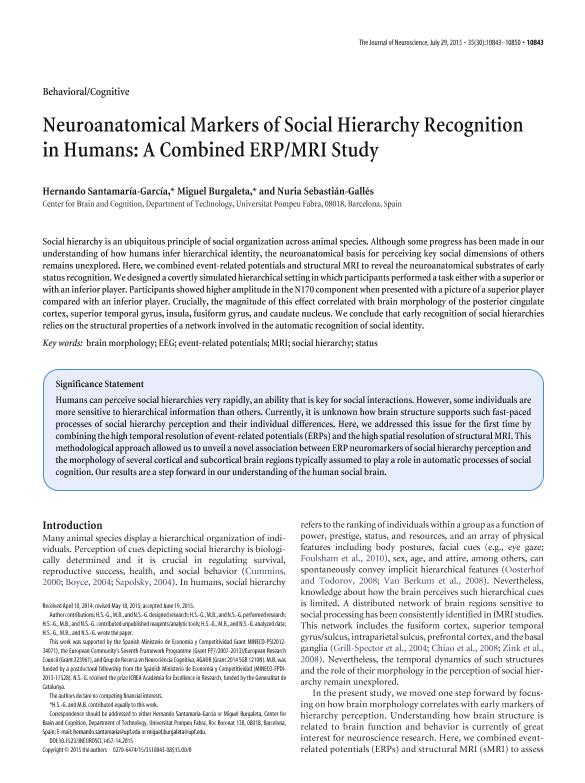Mostrar el registro sencillo del ítem
dc.contributor.author
Santamaria Garcia, Hernando

dc.contributor.author
Burgaleta, Miguel
dc.contributor.author
Sebastián-Gallés, Nuria
dc.date.available
2018-03-07T18:13:31Z
dc.date.issued
2015-07
dc.identifier.citation
Santamaria Garcia, Hernando; Burgaleta, Miguel; Sebastián-Gallés, Nuria; Neuroanatomical markers of social hierarchy recognition in humans: A combined ERP/MRI study; Society for Neuroscience; Journal of Neuroscience; 35; 30; 7-2015; 10843-10850
dc.identifier.issn
0270-6474
dc.identifier.uri
http://hdl.handle.net/11336/38141
dc.description.abstract
Social hierarchy is an ubiquitous principle of social organization across animal species. Although some progress has been made in our understanding of how humans infer hierarchical identity, the neuroanatomical basis for perceiving key social dimensions of others remains unexplored. Here, we combined event-related potentials and structural MRI to reveal the neuroanatomical substrates of early status recognition. We designed a covertly simulated hierarchical setting in which participants performed a task either with a superior or with an inferior player. Participants showed higher amplitude in the N170 component when presented with a picture of a superior player compared with an inferior player. Crucially, the magnitude of this effect correlated with brain morphology of the posterior cingulate cortex, superior temporal gyrus, insula, fusiform gyrus, and caudate nucleus. We conclude that early recognition of social hierarchies relies on the structural properties of a network involved in the automatic recognition of social identity. Significance Statement: Humans can perceive social hierarchies very rapidly, an ability that is key for social interactions. However, some individuals are more sensitive to hierarchical information than others. Currently, it is unknown how brain structure supports such fast-paced processes of social hierarchy perception and their individual differences. Here, we addressed this issue for the first time by combining the high temporal resolution of event-related potentials (ERPs) and the high spatial resolution of structural MRI. This methodological approach allowed us to unveil a novel association between ERP neuromarkers of social hierarchy perception and the morphology of several cortical and subcortical brain regions typically assumed to play a role in automatic processes of social cognition. Our results are a step forward in our understanding of the human social brain.
dc.format
application/pdf
dc.language.iso
eng
dc.publisher
Society for Neuroscience

dc.rights
info:eu-repo/semantics/openAccess
dc.rights.uri
https://creativecommons.org/licenses/by/2.5/ar/
dc.subject
Brain Morphology
dc.subject
Eeg
dc.subject
Event-Related Potentials
dc.subject
Mri
dc.subject
Social Hierarchy
dc.subject
Status
dc.subject.classification
Inmunología

dc.subject.classification
Medicina Básica

dc.subject.classification
CIENCIAS MÉDICAS Y DE LA SALUD

dc.title
Neuroanatomical markers of social hierarchy recognition in humans: A combined ERP/MRI study
dc.type
info:eu-repo/semantics/article
dc.type
info:ar-repo/semantics/artículo
dc.type
info:eu-repo/semantics/publishedVersion
dc.date.updated
2018-03-02T17:32:59Z
dc.identifier.eissn
1529-2401
dc.journal.volume
35
dc.journal.number
30
dc.journal.pagination
10843-10850
dc.journal.pais
Estados Unidos

dc.journal.ciudad
Washington, DC
dc.description.fil
Fil: Santamaria Garcia, Hernando. Universitat Pompeu Fabra; España. Consejo Nacional de Investigaciones Científicas y Técnicas; Argentina
dc.description.fil
Fil: Burgaleta, Miguel. Universitat Pompeu Fabra; España
dc.description.fil
Fil: Sebastián-Gallés, Nuria. Universitat Pompeu Fabra; España
dc.journal.title
Journal of Neuroscience

dc.relation.alternativeid
info:eu-repo/semantics/altIdentifier/doi/http://dx.doi.org/10.1523/JNEUROSCI.1457-14.2015
dc.relation.alternativeid
info:eu-repo/semantics/altIdentifier/url/http://www.jneurosci.org/content/35/30/10843
Archivos asociados
